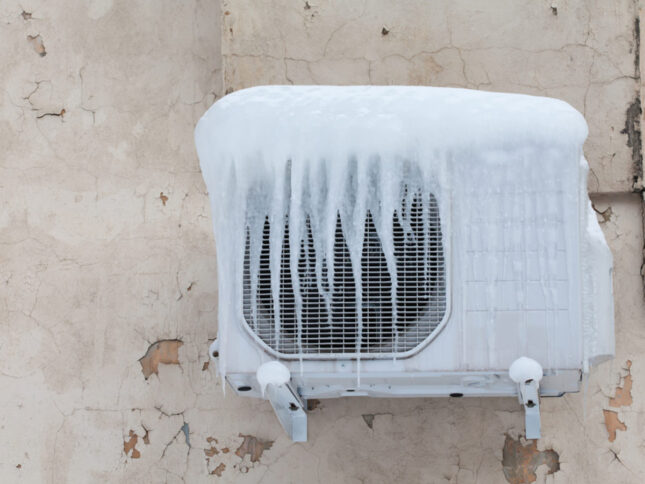Advice on Unfreezing a Frozen AC Pipe - Reinstating Normal Functionality
Advice on Unfreezing a Frozen AC Pipe - Reinstating Normal Functionality
Blog Article
Nearly everybody will have their own unique piece of advice about Have a Frozen AC Line? Here’s How to Fix It.

Intro
Uncovering that your AC pipeline is iced up can be worrying, particularly during hot summertime when you rely on your ac system one of the most. Recognizing what to do in such a scenario is important to avoid further damages to your cooling system and ensure your comfort indoors.
Understanding the Causes
Numerous variables can contribute to the cold of an a/c pipeline. Recognizing these causes can aid you attend to the issue successfully.
Absence of Airflow
One typical source of a frozen a/c pipe is inadequate airflow. When the airflow over the evaporator coil is restricted, it can cause the coil to go down below freezing temperature, bring about ice development on the pipeline.
Low Refrigerant Levels
Not enough refrigerant levels in your AC system can additionally result in an icy pipe. Reduced refrigerant degrees can trigger the pressure in the system to go down, bring about the cold of wetness on the evaporator coil.
Cold Weather Conditions
In colder climates, freezing temperatures outside can contribute to the freezing of a/c pipes. If your AC system is not correctly protected or if there are leaks in the ductwork, chilly air can penetrate the system, triggering the pipe to freeze.
Dirty Air Filters
Filthy or clogged air filters can limit air movement in your air conditioning system, causing various issues, including a frozen pipeline. It's necessary to change or cleanse your air filterings system routinely to guarantee appropriate air movement and avoid ice build-up.
Signs of a Frozen Air Conditioning Pipe
Identifying the indicators of a frozen AC pipeline is critical for prompt action.
Minimized Airflow
If you see a substantial decline in air movement from your vents, it can suggest a frozen pipeline.
Ice Buildup on the Pipe
Visible ice buildup on the refrigerant line or the evaporator coil is a clear indication of a frozen air conditioning pipe.
Odd Sounds from the Unit
Uncommon audios, such as hissing or gurgling, originating from your air conditioner unit can signal that there's ice existing on the pipeline.
Immediate Actions to Take
When confronted with an icy a/c pipe, it's vital to act promptly to avoid additional damages to your air conditioning system.
Shutting off the a/c
The very first step is to shut off your air conditioning system to stop the system from running and worsening the problem.
Checking for Blockages
Examine the area around the indoor device for any kind of blockages that may be blocking airflow, such as furnishings or curtains.
Thawing the Pipe
You can use mild techniques like putting towels taken in cozy water around the frozen pipe to help thaw it gradually.
Safety nets
Taking preventive measures can aid stay clear of future incidents of an icy air conditioner pipeline.
Normal Maintenance Checks
Arrange regular maintenance checks with a specialist HVAC service technician to guarantee that your AC system is running effectively.
Changing Air Filters
Regularly change or clean your air filters to prevent air movement limitations and maintain optimum performance.
Insulating Exposed Pipes
If your a/c pipes are revealed to cold temperature levels, think about shielding them to stop freezing throughout winter season.
Seeking Professional Help
If DIY techniques fail to solve the problem or if you're unclear regarding just how to proceed, it's best to look for support from a qualified HVAC technician.
When DIY Methods Fail
If your efforts to thaw the pipeline or address various other problems are not successful, it's time to contact a professional.
Value of Hiring a Professional HVAC Technician
A certified HVAC service technician has the experience and tools necessary to diagnose and fix issues with your air conditioning system safely and properly.
Conclusion
Handling a frozen a/c pipe can be an irritating experience, however recognizing how to react can aid minimize damages and bring back convenience to your home. By recognizing the reasons, recognizing the indications, and taking timely action, you can successfully attend to the problem and protect against future events.
G UP? HOW TO FIX IT?
It happens all over America. And the rest of the world probably. It’s the hottest day ever and for some darn reason your AC isn’t cooling the house. You fiddle with the thermostat to try and fix the problem. Nada. All you can do now is go outside and check the AC unit. You make your way there and find your air conditioner unit is frozen! But how?
In this post we’ll cover how you can tell that your air conditioner has frozen (other than the obvious reasons), what could have caused the freeze, and some of the things you can do about your AC freezing up. And if you have a frozen heat pump condenser, read our blog about it to learn what to do! But remember, it is always best to avoid your AC freezing up with an AC tune up. And if you are moving into a home, it's critical to get HVAC inspection so that you are aware of an AC problems before you move in.
Keep reading and you may be able to fix the frozen AC yourself. If you can’t, call an HVAC specialist. If you live in Maryland, call SuperTech HVAC for AC repair. We’ll take care of it.
How Does An Air Conditioning Unit Work?
How you probably imagine an AC works is wrong. Contrary to popular belief, an AC system does not inject cool air into a building. Instead, it removes the heat from inside and transfers it outside. Cool huh? (Pun intended).There are 4 major components among the 3 stations of an air conditioning system: the evaporator coil, the compressor, the condenser, and the refrigerant – a special chemical that links everything together through a closed loop system.
Station 1:
Warm indoor air is sucked into the return vent, through a filter, and blows over the evaporator coil. The heat is absorbed into the cold refrigerant, turning it from liquid to gas. The air, which is now cool, is blown back into the home to areas that your thermostat, i.e. you, has decided.
Station 2:
The refrigerant makes its way outside the house to the compressor, which squeezes the warm refrigerant, raising its gaseous temperature even more.
Station 3:
When the super hot vapor refrigerant reaches the condenser, the last step, the heat is expelled and absorbed into the outdoor air. The refrigerant instantly cools, which changes it from gas back to liquid form. The cold liquid refrigerant is now ready to return to station 1 and repeat the process.
Is Your AC Freezing Up? Here Are The Signs:
As you may have guessed, your air conditioner unit freezing up on a hot day is not normal.
If this happens, there's no need to panic. Often the issue can be solved with a little troubleshooting. If the AC unit is left frozen for too long however, you may find yourself with a bigger problem.
First things first, how do you know your AC is frozen?
Well, the obvious sign is the ice on your refrigerant line-set pipe. Simply check between your outdoor AC unit and your home's exterior wall to see whether your AC line frozen.
You might also have a frozen evaporator coil. This one's not as easy to check. You'll need to open a panel on the indoor unit to inspect. Don't do this unless you're handy. If you aren't, call an HVAC pro like SuperTech HVAC or you may damage something in the process.

I'm certainly very intrigued by Air Conditioner Frozen? How To Fix your Frozen AC Line and I am assuming you enjoyed the entire blog posting. For those who appreciated our blog entry please remember to pass it around. Many thanks for your time invested reading it.
This Website Report this page